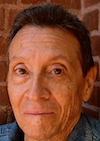 (In my previous post, I presented the first half of my February 1, 1968 profile of and interview with Josiah “Tink” Thompson, author of the now-classic, controversial Six Seconds in Dallas: A Micro-Study of the Kennedy Assassination. Here’s the second half. ― A. D. C.)
(In my previous post, I presented the first half of my February 1, 1968 profile of and interview with Josiah “Tink” Thompson, author of the now-classic, controversial Six Seconds in Dallas: A Micro-Study of the Kennedy Assassination. Here’s the second half. ― A. D. C.)
•
Six Seconds in Dallas: This Void of Silence (cont’d)
Metastasis: the transfer of disease from one part of the body to another with the development of the characteristic lesion in the new location, as in cancer.
Almost 2 years ago, when I was playing and singing in a now-defunct San Francisco electric band, our lead guitarist and I composed a gentle, melancholy ballad in an Elizabethan voice. This was the last stanza:
In this void where silence reigns,
I would cry a killer’s name:
Your false king wears robes his knives once tore.
Yes, we heroes drop your arms,
And we scholars close your books;
Now we minstrels slip out through your door.
We’ve nothing left to offer anymore.
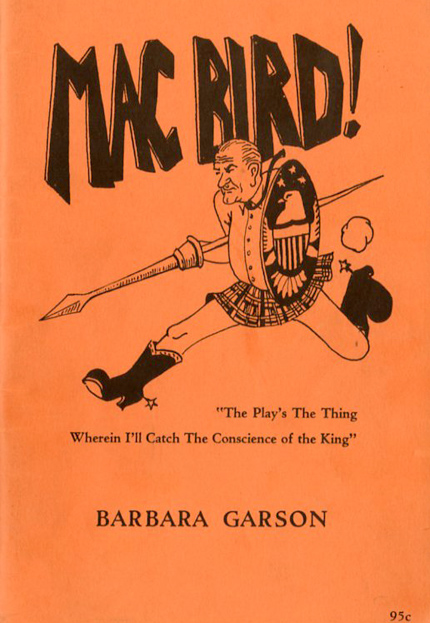
Barbara Garson, “MacBird” (1967), cover
Over the past few years I have met few people who do not suspect that Lyndon Baines Johnson is implicated in the plot to kill Kennedy, either before the act or ex post facto. MacBird! [a 1967 satire by Barbara Garson that merges the Kennedy assassination with the plot of Shakespeare’s Macbeth] ran to overflow audiences at New York’s Village Gate for many months. Some critics of the Warren Commission Report have hinted at the possibility. The Garrison investigation pursues its steady course despite hysterical attempts to discredit it, and, in the latest issue of Ramparts, Garrison himself states that Johnson has been of notable help in covering up evidence. Paul Krassner ran a fictitious excerpt [in The Realist] from the Manchester book [William Manchester, The Death of a President: November 20–November 25, 1963] in which Johnson fucked Kennedy’s corpse through the throat wound, and people believed it.
This speculation is widespread. It makes top-notch cocktail party conversation. But it goes no further. No one is outraged. No one really cares, one way or the other.
•
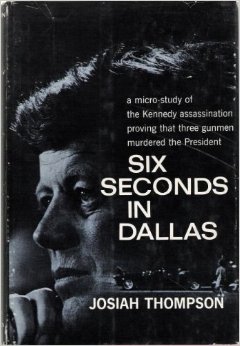
Josiah Thompson, Six Seconds in Dallas (1967), cover.
Tink Thompson does not believe it. His opinion of Johnson is low, but he cannot conceive of his being involved in the assassination. At any rate, such unscientific speculations are irrelevant to his goals and purposes as an investigator and author. Six Seconds in Dallas is what he, and his publishers, describe as a “micro-study” of the assassination. (“I’m proud of that title,” Tink said of Six Seconds in Dallas. “Thought it up myself. That’s all the book is about — what happened in those six seconds.”)
The title, like his argument, is concise and accurate. Concentrating lucidly on the six seconds during which the fatal shots were fired, using existing evidence and no speculation, Thompson proves that those shots were fired by three gunmen. He proves no more — and no less. For the validity of his argument discredits the very foundation of the Warren Commission Report, based as it is on the theory that Oswald acted alone.
Thompson’s work, unlike that of his predecessors, is not speculative; he is not theorizing. Six Seconds in Dallas does not concern itself at all with the who and why of the act. Tink Thompson was after truth, scientific, factual truth, since he feels that is the only basis from which answers to the other questions can be deduced. So he eliminated from his investigation all but the definable moments of truth: the six seconds in which the act was committed. Using strictly scientific methods — analyses of the timing of the shots, trajectories, angles of bullet entry, effects of impact — and working primarily from the evidence recorded by film, he proves beyond question that the shots were fired by three assassins.
His conclusions are not based on flimsy hypothetical coincidences. They are derived from the recorded evidence — much of it in the Zapruder film — by application of the fundamental laws of physics. (in preparing the book, Thompson became an autodidactic expert in various phases of photoanalysis, and most of his argument is supported by the photographs.)
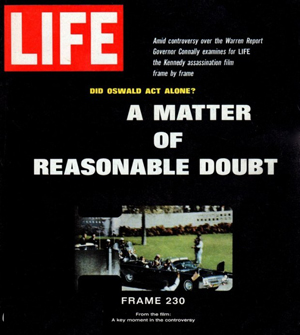
LIFE magazine, November 25, 1966, cover
As I noted above, much of his thesis — immensely readable, enjoyable simply as the smooth and logical functioning of a mind invested with honed intelligence and clarity of perception — is based upon the original copy of the Zapruder film, which is in the possession of Life magazine. Thompson had much opportunity to study that film when working for Life as a consultant on the assassination. He claims that careful examination of that copy (the Warren Commission worked from a copy of a copy of the original) provides clear evidence that the shots could not all have been fired by the same man.
He expected Life to release that news over a year ago; his book was written after their decision not to run the story. Recently, in a bizarre attempt at self-protection, Life refused permission to reproduce four crucial frames from the Zapruder film in Six Seconds, despite an offer from Thompson and Geis by which Life would have received all profits from the book in return for the right to use those four frames. Life refused, and the magazine has filed suit against the book; if they win, it will be impounded and, presumably, destroyed.
The four frames in question show clearly that, among other things, Governor Connolly was struck by a different shot than that which hit the president. Since the single-bullet theory — necessary to support the lone-assassin argument — is vital to the Warren Commission’s conclusion, actual photographic proof to the contrary shatters the structure of that report completely.
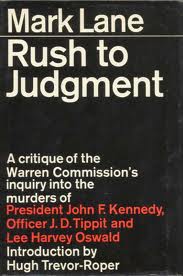
Mark Lane, “Rush to Judgment” (1966), cover
“When I saw Life‘s original of the Zapruder film,” Tink told me, “I knew the case was broken right then and there. So I called Don Preston, executive editor at Geis, and told him to forget the book, Life would be breaking the story. That was in the fall of 1966.”
Musing about the lawsuit, he said calmly, “I have no expectations of making any money off this book.” He did not seem disappointed; he was astonished enough by the $500 Geis gave him as an advance on the book, and the expense account Geis allowed him during his publicity tour. (He insisted on paying for our drinks, and went so far as to tip the hat-check girl for my coat, for all the world like a young kid with a $5 bill Christmas present.)
“If this book gets those four frames sprung from Life, it will have succeeded,” he continued. “If those are released, the pressure for reopening the case will become irresistible. And if I’m bluffing, Life can call me on it.” How long, I wondered, would he go on talking, trying to get someone to take action? “If the case doesn’t break by [next] February, fuck it.” That was one of the few four-letter words he uttered all evening; In context, it was shocking in its bitterness.
By then we’d both had two drinks, and the conversation — at least my end of it — was beginning to unravel. In a last-ditch attempt to stick to the subject, I asked what effect he expected the book to have on the public. “If I were the man in the street,” he spoke eagerly, “and I read what I’ve written here, I’d damn well want to do something!” What, I said softly. “Write my congressman, call someone, send letters to the Editor of the Times, about . . . you know, that was a hell of a good question.” Then I asked him to autograph my review copy of the book, which he did with a childish delight, and I walked out into New York and the winter street, leaving Tink in the lobby, collecting his messages at the front desk.
•
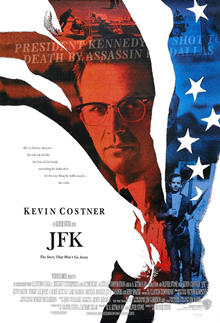
Oliver Stone, “JFK” (1991), poster
Downtown Dallas is much like downtown San Francisco and downtown New York. There is more brooding violence in the East Village. In downtown Dallas, at a restaurant called The Cattleman, I ate the best steak I have ever tasted — perfect meat, superbly cooked; meat which had been understood. The diners around me were dressed in fashionable clothes, tasteful and sedate. Their necks were not red. They were the norm; the walking Marlboro ads I spotted occasionally appeared more and more anomalous as the week wore on.
After dinner I walked to Dealey Plaza. It was a chill, clear night, bright and crisp. The Texas School Book Depository, the overpass, the grassy knoll, stood moonlit in silence. They were invested with no magic, no flickering aura of evil, no looming atmosphere of historicity. It was all merely, disappointingly, there. No tears came. I walked back to my hotel.
•
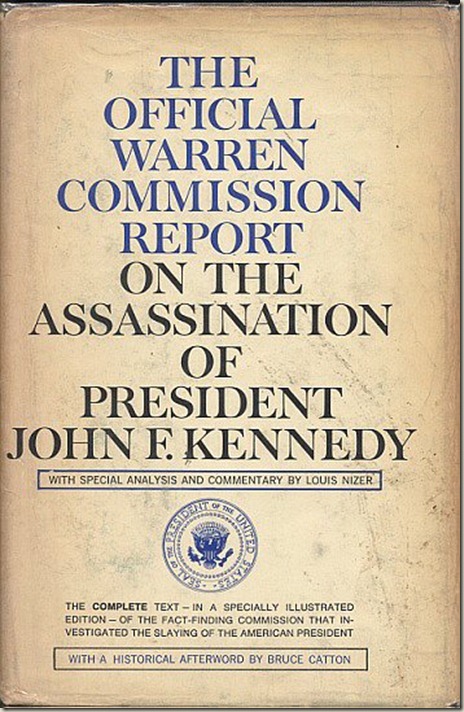
Warren Commission Report (1964), cover
I take no position nowadays on the rightness or wrongness of any version of the Kennedy assassination save this: The lone-gunman theory ― the assertion that Lee Harvey Oswald acted alone, and entirely on his own initiative ― has no more plausibility in 2013 than it did on November 22, 1963.
I don’t intend to enter the rancorous territory of JFK conspiracy theory. Thompson has his detractors, and his enemies, but he’s remained a calm, clear spokesman for his own ideas ― which, after all these years, he continues to restrict to the physical evidence and what he interprets that to reveal.
You’ll find lots of material by and about Thompson by doing an online search of his name. For starters, here’s a short bio, a forum q&a with him, his public recantation of a mistaken assertion, and a more recent video in which he reads from his forthcoming book, “Last Second in Dallas.”
•
What I took away from Thompson’s book that nourished my budding inclination to start working as a photography critic was this: Close, patient attention to the particulars of lens-derived images would reward the viewer in unpredictable ways.
One more thing: The original typescript of this article may reside somewhere in the Village Voice archives. My carbon copy thereof disappeared decades ago. I have a clipping of the original published version, pasted into a looseleaf binder that’s in storage right now and inaccessible.
So, to present it to you, I did an online search and came up with a PDF of it, which you’ll find here. It comes from the Harold Weisberg Archive at Hood College in Fredericksburg, MD, “the world’s largest accessible private collection of government documents and public records relating to the assassination of President John F. Kennedy.” (The college has digitized the archive and put it online for researchers; I have no objection to their inclusion of this article for such purposes.)
The PDF contains the entire article, as published, with a curious handwritten note above the article’s title on the first page: “I get the distinct impression from this article that Thompson is gay.”
Harold Weisberg’s handwritten note on A. D. Coleman article about Josiah Thompson: “I get the distinct impression from this article that Thompson is gay.”
I’ve no idea what gave this note’s author (Weisberg himself, I presume) that idea. Re-reading the article in print, and reading it vocally into a Word file using Apple’s Dictation app, I found nothing in my text or tone to suggest that Thompson had an orientation other than hetero, as the several mentions of his wife would indicate. Certainly I had no intention of insinuating otherwise. (Not that there’d have been anything wrong with that, for either myself or the Voice readership, in 1968.)
Why should this have mattered to Weisberg, enough to inscribe it in pen on the article? Beats me. But it does show you what happens when, as a researcher, you turn your attention to the primary materials. As Robert Coover wrote in The Public Burning (1977), “‘Objectivity’ is in spite of itself a willful program for the stacking of perceptions; facts emerge not from life but from revelation, gnarled as always by ancient disharmonies and charged with libidinous energy.”
(Part 1 I 2)
•
This post supported by a donation from Yoshio Kishi.






I just spent a most unsettling half an hour or so following some of the links you put in this article. The power and shock of that footage never goes away. Horrible.
I was wondering whether you are aware that Adobe have come up with an “anti-shake” filter. It measures the duplicated points that occur as a result of camera movement and stitches them back so they are all on top of each other (where they should be). I wonder if the blurred (Zapruder) frame could be reconstituted using this tool?
From what I read in researching these two posts, Thompson and other investigators of the assassination have applied every pertinent technology to their inquiries, from the outset. It has become the single most investigated crime (forensically speaking) of all time. If anti-shake applications would help, then they’ll surely get employed, if that hasn’t already happened.
Whether that would reveal anything of use I don’t know. But I do know this: By the inexorable logic of paranoia, the authenticity of every single piece of evidence in this case faces challenges from one or another camp of conspiracy theorists. This includes all the film and still footage of the event, with the Zapruder film at the top of that list. So the “reconstituting” of that frame would become instantly controversial. Not that it shouldn’t get done ― just that the person doing it would instantly go under a high-powered microscope for motive, and the results would face constant impeachment from various quarters.